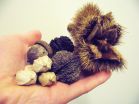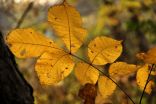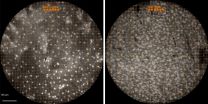INFORMATION:
PHOTOS: http://www.buffalo.edu/news/releases/2015/05/048.html END
Study explores how past Native-American settlement modified Western New York forests
Fire-tolerant trees that bear edible nuts were unusually abundant near the historical sites of Native American villages, research suggests
2015-06-02
(Press-News.org) BUFFALO, N.Y. -- A new study by University at Buffalo geographers explores how humans altered the arboreal make-up of Western New York forests before European settlers arrived in large numbers.
The research looked at land survey data from around 1799-1814, and used this information to model which tree species were present in different areas of Chautauqua County, New York, at that time.
The analysis placed hickory, chestnut and oak trees in larger-than-expected numbers near the historical sites of Native American villages, said co-author Steve Tulowiecki, who conducted the research as a geography PhD candidate at the University at Buffalo and is now an adjunct lecturer of geography at SUNY Geneseo. This finding is important because these species produce edible nuts, and are also more likely than many other trees to survive fires.
"Our results contribute to the conversation about how natural or humanized the landscape of America was when Europeans first arrived," Tulowiecki said. "Our society has competing views about this: On one hand, there is the argument that it was a wilderness relatively untouched by man. Recently, we've had this perspective challenged, with some saying that the landscape was dramatically altered, particularly through burning and other clearance practices."
The findings of the new research -- more fire-tolerant, large-nut-bearing trees than expected within about 15 kilometers of village sites -- suggest that Native American communities in the study area modified the forest in ways that favored those species, Tulowiecki said. He noted that flame-sensitive beech and sugar maples, which burn readily in forest fires, appeared in smaller numbers than expected near village sites.
Forest modifications may have impacted upwards of 20 percent of total land area in modern-day Chautauqua County, according to Tulowiecki's analysis.
The research is important, he said, because it uses data to address questions surrounding historical forest modification.
"There have been contentious debates over the past few decades regarding the spatial extent of Native American impacts upon pre-European landscapes," he said. "Yet, very few studies have offered exhaustive methods to understand or quantify these impacts. Our study utilizes advanced quantitative models, geographic information systems, original land survey data, and historical-archaeological records of Native American settlement in order to understand these impacts."
Tulowiecki, who finished his PhD in 2015, conducted the study with his advisor, UB Associate Professor of Geography Chris Larsen, PhD. The research was published online on May 19 in Ecological Monographs, a journal of the Ecological Society of America.
Picturing a 19th-century forest
To predict how the forest looked 200 years ago, Tulowiecki and Larsen synthesized several sources of information.
They began with the observations of surveyors from the Holland Land Company, who documented the terrain of Chautauqua County between 1799 and 1814. These assessors included details on which types of trees they found at thousands of locations in the region.
Tulowiecki and Larsen mapped this information, then overlaid it with data showing the temperature, precipitation, soil conditions and other environmental variables at different locations. This helped the researchers understand what types of trees typically grew under various conditions, and they used this information to build predictive models showing how all of Chautauqua County would have looked, tree-wise, at the turn of the 19th century if environmental conditions were the only factor at play.
Apparently, they were not, because in some places the distribution of tree species predicted by the model didn't match the reality of what surveyors saw.
The sites where these discrepancies occurred coincided with the historical location of Native American villages as mapped or described by various sources, Tulowiecki says. This suggested that Native American societies - particularly the Seneca - modified the areas surrounding their communities.
To account for this possibility, the researchers refined their predictive models. In addition to the original environmental variables, they incorporated a new variable that captured information related to proximity to village sites.
The models improved as a result.
ELSE PRESS RELEASES FROM THIS DATE:
Reflection in medical education can lead to less burn-out
2015-06-02
MAYWOOD, Ill. - Drawing on its Jesuit Catholic heritage, Loyola University Chicago Stritch School of Medicine has long understood the importance of reflection in medical education as a key element in physician formation. With physician burnout on the rise, it is all the more integral for students to learn ways to engage better with the challenges faced in the medical profession. Stritch faculty members believe reflection is a fundamental tool to help students process and cope with the tremendous physical, emotional, and mental pressure that can accompany their vocation.
These ...
McMaster researchers discover key to maintaining muscle strength while we age
2015-06-02
Hamilton, ON (June 2, 2015) - What causes us to lose muscle strength as we age and how exercise can prevent it from happening has never been thoroughly understood, but McMaster University researchers have discovered a key protein required to maintain muscle mass and muscle strength during aging.
This important finding means new and existing drugs targeting the protein may potentially be used to preserve muscle function during aging.
"We found that the body's fuel gauge, AMP-activated protein kinase (AMPK), is vital to slow muscle wasting with aging," said Gregory Steinberg, ...
New study: Gut bacteria cooperate when life gets tough
2015-06-02
Researchers of the Luxembourg Centre for Systems Biomedicine (LCSB) of the University of Luxembourg have discovered with the help of computer models how gut bacteria respond to changes in their environment - such as a decrease in oxygen levels or nutrient availability. Microorganisms that normally compete or overthrow one another can switch to a cooperative lifestyle when their living conditions change: They even start producing substances to make life easier for the other species, helping them to survive. The entire microbial community then stabilises - and together adapts ...
Is our first line of defense sleeping on the job?
2015-06-02
New Orleans, Louisiana - June 1, 2015 - The skin microbiome is considered our first line of defense against pathogens. Across our bodies, we are covered with a diverse assemblage of bacteria. However, the skin can be a harsh environment for beneficial bacteria to live on due to UV exposure, high salinity, and desiccation stress. Research being presented at the annual meeting of the American Society for Microbiology found that these suboptimal conditions may cause some bacteria to enter a dormant state, while other bacteria may simply die.
In this study, Sarah Cummins ...
Oral bacterium possibly associated with systemic disease found in Alabama schoolchildren
2015-06-02
New Orleans, Louisiana - June 1, 2015 - Prevalence of a recently discovered serotype of oral bacterium, with a possible link to a number of systemic diseases, was found for the first time in a small cohort of African-American schoolchildren in a southwest Alabama town, according to research being presented at the annual meeting of the American Society for Microbiology.
Streptococcus mutans serotype k, first discovered in Japan in 2004, has been linked to a number of systemic diseases, including bacteremia, infective endocarditis and hemorrhagic stroke. "However, the bacteria ...
Does Agion silver technology work as an antimicrobial?
2015-06-02
New Orleans, Louisiana - May 31, 2015 - The antibacterial effectiveness of Agion silver zeolite technology was tested on door handles across the Penn State Erie campus and after four years of sampling, a significant difference was observed between the bacterial populations isolated from silver versus control-coated door handles. This research is presented at the annual meeting of the American Society for Microbiology.
"In our study we have analyzed the bacterial populations found on silver- and control-coated door handles within four different building on the Penn State ...
Scientists discover a protein that silences the biological clock
2015-06-02
A new study led by UC Santa Cruz researchers has found that a protein associated with cancer cells is a powerful suppressor of the biological clock that drives the daily ("circadian") rhythms of cells throughout the body. The discovery, published in the June 4 issue of Molecular Cell (and online now), adds to a growing body of evidence suggesting a link between cancer and disruption of circadian rhythms, while offering new insights into the molecular mechanisms of the biological clock.
The ticking of the biological clock drives fluctuations in gene activity and protein ...
Saving money and the environment with 3-D printing
2015-06-02
A Northwestern University team has confirmed a new way to help the airline industry save dollars while also saving the environment. And the solution comes in three dimensions. By manufacturing aircrafts' metal parts with 3-D printing, airlines could save a significant amount of fuel, materials, and other resources.
Led by Eric Masanet, the team used aircraft industry data to complete a case study of the life-cycle environmental effects of using 3-D printing for select metal aircraft parts, a technique that is already being adopted by the industry. The team concluded that ...
Chemists weigh intact virus mixture with mass spectrometer
2015-06-02
Carnegie Mellon University chemists, led by Mark Bier, have separated and weighed virus particles using mass spectrometry (MS). This is the first time that researchers successfully used matrix-assisted laser desorption ionization MS to analyze a mixture of intact virus particles.
Bier, research professor of chemistry and director of Carnegie Mellon's Center for Molecular Analysis, and graduate student Logan Plath will present their findings in a poster session at the American Society for Mass Spectrometry Conference on Mass Spectrometry and Allied Topics today, June 2, ...
Microendoscope could eliminate unneeded biopsies
2015-06-02
In a clinical study of patients in the United States and China, researchers found that a low-cost, portable, battery-powered microendoscope developed by Rice University bioengineers could eventually eliminate the need for costly biopsies for many patients undergoing standard endoscopic screening for esophageal cancer.
The research is available online in the journal Gastroenterology and was co-authored by researchers from nearly a dozen institutions that include Rice, Baylor College of Medicine, the Chinese Academy of Medical Sciences and the National Cancer Institute.
The ...
LAST 30 PRESS RELEASES:
Superradiant spins show teamwork at the quantum scale
Cleveland Clinic Research links tumor bacteria to immunotherapy resistance in head and neck cancer
First Editorial of 2026: Resisting AI slop
Joint ground- and space-based observations reveal Saturn-mass rogue planet
Inheritable genetic variant offers protection against blood cancer risk and progression
Pigs settled Pacific islands alongside early human voyagers
A Coral reef’s daily pulse reshapes microbes in surrounding waters
EAST Tokamak experiments exceed plasma density limit, offering new approach to fusion ignition
Groundbreaking discovery reveals Africa’s oldest cremation pyre and complex ritual practices
First breathing ‘lung-on-chip’ developed using genetically identical cells
How people moved pigs across the Pacific
Interaction of climate change and human activity and its impact on plant diversity in Qinghai-Tibet plateau
From addressing uncertainty to national strategy: an interpretation of Professor Lim Siong Guan’s views
Clinical trials on AI language model use in digestive healthcare
Scientists improve robotic visual–inertial trajectory localization accuracy using cross-modal interaction and selection techniques
Correlation between cancer cachexia and immune-related adverse events in HCC
Human adipose tissue: a new source for functional organoids
Metro lines double as freight highways during off-peak hours, Beijing study shows
Biomedical functions and applications of nanomaterials in tumor diagnosis and treatment: perspectives from ophthalmic oncology
3D imaging unveils how passivation improves perovskite solar cell performance
Enriching framework Al sites in 8-membered rings of Cu-SSZ-39 zeolite to enhance low-temperature ammonia selective catalytic reduction performance
AI-powered RNA drug development: a new frontier in therapeutics
Decoupling the HOR enhancement on PtRu: Dynamically matching interfacial water to reaction coordinates
Sulfur isn’t poisonous when it synergistically acts with phosphine in olefins hydroformylation
URI researchers uncover molecular mechanisms behind speciation in corals
Chitin based carbon aerogel offers a cleaner way to store thermal energy
Tracing hidden sources of nitrate pollution in rapidly changing rural urban landscapes
Viruses on plastic pollution may quietly accelerate the spread of antibiotic resistance
Three UH Rainbow Babies & Children’s faculty elected to prestigious American Pediatric Society
Tunnel resilience models unveiled to aid post-earthquake recovery
[Press-News.org] Study explores how past Native-American settlement modified Western New York forestsFire-tolerant trees that bear edible nuts were unusually abundant near the historical sites of Native American villages, research suggests



